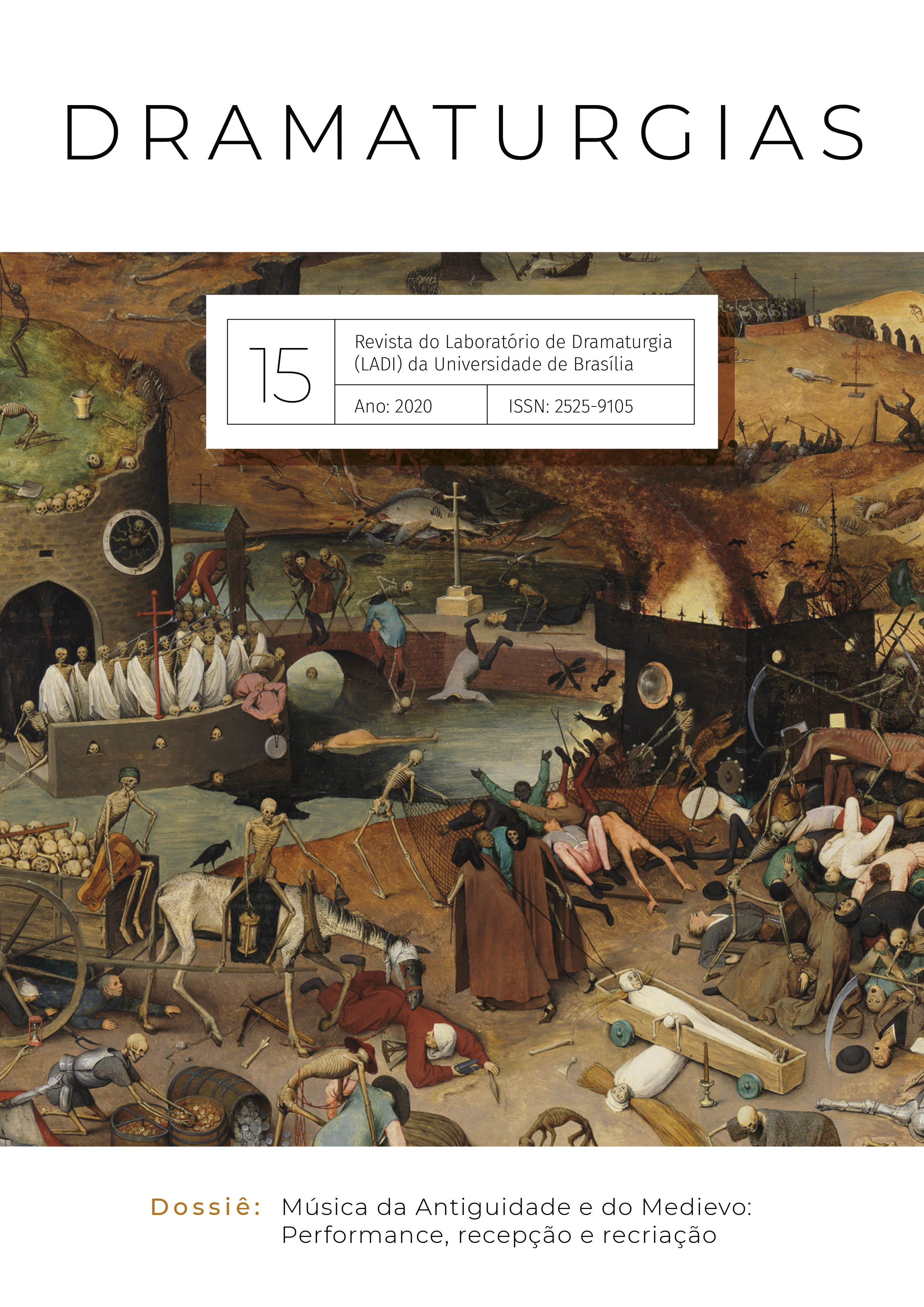Thinking about performance in galician-portuguese songs: challenges between orality and the manuscript tradition of the troubadours
DOI:
https://doi.org/10.26512/dramaturgias15.35750Keywords:
Galician-Portuguese songs, Performance, Historical MusicologyAbstract
Apart from the significant increase in interest in the Middle Ages by the public, Galician-Portuguese medieval songs still represent a great challenge for its interpretation and recreation today. Motivated by this issue, we propose, in this paper, a debate on the construction of the performance of Galician-Portuguese songs recognizing its specificities as a song in a context of creation and oral transmission. Therefore, we will analyze the perspectives and methods proposes by Musicology and the Early Music movement for medieval sources and the main challenges in view of the scarce material of the ‘Vindel’ and ‘Sharrer’ scrolls, fragments that contain cantigas de amigo and cantigas de amor, respectively, with musical notation. We consider that the concept of performance and its understanding in the medieval context is fundamental to advance in the understanding of troubadour performance, whose own songs provide some evidence, which we intend to explore in this article.
References
LOPES, Graça Videira; Ferreira, Manuel Pedro et al. (2011-). Cantigas Medievais Galego Portuguesas [base de dados online]. Lisboa: Instituto de Estudos Medievais, FCSH/NOVA. Último acesso em 15 de agosto de 2020. Disponível em:
<http://cantigas.fcsh.unl.pt>.
ALMEIDA, Scarlett Dantas de Sá. Ritos, cerimoÌ‚nias e poder em Castela: uma análise político-cultural dos costumes de corte (séc. XV). Dissertação de mestrado defen- dida no Programa de Pós-Graduação em História da Universidade de Brasília, 2016.
AUBERT, E. H. L’anthropologie historique par le détour de la musicologie : une ethnomusicologie historique du Moyen AÌ‚ge est-elle souhaitable ? In: L’Atelier du Centre de recherches historiques [En ligne], 06 | 2010, mis en ligne le 29 juin 2010. Disponível em: http://journals.openedition.org/acrh/1916; DOI: https:// doi.org/10.4000/acrh.1916. Acesso em 27 de julho de 2020.
AUBREY, Elizabeth. Reconsidering “High Style” and “Low Style” in Medieval Song. In: Journal of Music Theory, vol. 52, no 1, 2008, p. 75 ”“ 122.
BERGER, Anna Maria Berger. Medieval Music and the Art of Memory. University of California Press, 2005.
BLACKING, J. How musical is man? University of Washington Press, 1974.
CHAILLOU-AMADIEU, Christelle. « Faire gaia chanso »: la tradition des trouba- dours, un art de faire entre musique et littérature ». In: Cahiers de recherches médiévales et humanistes, [En ligne] 26 | 2013, mis en ligne le 30 décembre 2016, p. 57-68. Disponível em http://journals.openedition.org/crm/13392; DOI:
4000/crm.13392. Acesso em 22 de julho 2019.
COHEN, Rip. “In the Beginning was the Strophe: Origins of the Cantiga d’Amigo Revealed!”. In: LARANJINHA, Ana Sofia; MIRANDA, José Carlos (Coords.). Modelo: Actas do X Colóquio da Secção Portuguesa da Associação Hispá‚nica de Literatura Medieval. Porto: Faculdade de Letras da Universidade do Porto, 2005, pp. 243-255.
ECO, Humberto. Arte e beleza na Estética Medieval. Rio de Janeiro: Record, 2018. FERREIRA, Manuel Pedro. Cantus Coronatus: 7 Cantigas d’El-Rei Dom Dinis. Kassel:
Reichenberger, 2005.
______________________. Estrutura e ornamentação melódica nas cantigas trovado- rescas. In: FERREIRA, M. P. Aspectos da Música Medieval no Ocidente Peninsular, vol. 1: Música Palaciana. Lisboa: Imprensa Nacional/ Fundação Calouste Gulbenkian, 2009, p. 150 ”“ 174.
______________________. Ler o Pergaminho Vindel: suporte; textos; autor. In: Lopes, Graça Videira; FERREIRA, Manuel Pedro (eds). Do Canto à Escrita: Novas ques- tões em torno da lírica galego-portuguesa ”“ nos cem anos do Pergaminho Vindel. Lisboa: IEM/CESEM, 2016.
KELLY, Thomas Forest. Early Music. A very short introduction. Oxford University Press, 2011 (E-book Kindle).
LE GOFF, J. Heróis e Maravilhas da Idade Média. Petrópolis: Vozes, 2011. MICHELS, Ulrich. Atlas de música vol I. Lisboa: Gradiva, 2003.
MONGELLI, Lênia Marcia. Fremosos Cantares: Antologia da lírica medieval gale- go-portuguesa. São Paulo: Martins Fontes, 2009.
OLIVEIRA, António Resende. Depois do espetáculo trovadoresco. A estrutura dos cancioneiros peninsulares e as recolhas dos séculos XIII e XIV. Lisboa: Colibri, 1994.
SHARRER, H. Fragmentos de sete cantigas d’Amor de D. Dinis, musicadas ”“ uma Descoberta. In: Literatura Medieval Vol. I: Actas do IV Congresso da Associação Hispá‚nica de Literatura Medieval. Lisboa: Cosmos, 1991.
SODRÉ, Paulo Roberto. O riso no jogo e o jogo do riso na sátira galego-portu- guesa. Vitória: EDUFES, 2010.
TAVANI, G. Trovadores e Jograis: Introdução à poesia medieval galego-portu- guesa. Lisboa: Caminho, 2002.
TOMLINSON, Gary. Musicology, Anthropology, History. In: Il Saggiatore Musicale, vol. 8, no1, 2001, p. 21 ”“ 37.
ZUMTHOR, Paul. A letra e a voz. A literatura medieval. São Paulo: Companhia das Letras, 1993.
______________________. Performance, recepção e leitura. São Paulo: Cosac Naify, 2007.
Downloads
Published
Issue
Section
License
Copyright (c) 2020 Felipe Ferreira de Paula Pessoa

This work is licensed under a Creative Commons Attribution-ShareAlike 4.0 International License.
Autores mantém os direitos autorais e concedem à revista o direito de primeira publicação, com o trabalho simultaneamente licenciado sob a Licença Creative Commons Attribution que permite o compartilhamento do trabalho com reconhecimento da autoria e publicação inicial nesta revista.



